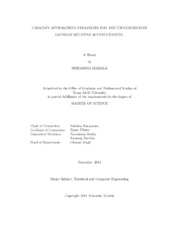| dc.description.abstract | The Gaussian Multiple access channel (GMAC) is a well-studied multi user channel in information theory and communication theory. The capacity of the GMAC can be achieved in theory and closely approached with practical coding schemes when there is coordination between the transmitters and the base station. In recent years, there has been growing interest in the design of uncoordinated multiple access or random access schemes for the GMAC, where there is no coordination between the users and the base station. The performance of such random access schemes with iterative collision resolution or Successive Interference Cancellation (SIC) for the interference-limited channel has been studied in previous works and the results show that the through put efficiency of random access schemes can be as high as those of coordinated multiple access schemes. However, these works do not consider transmit power constraints and additive white Gaussian noise at the receiver.
In this thesis, we consider the design of uncoordinated multiple access schemes that explicitly consider transmit power constraint and additive white Gaussian noise. We first show that direct extensions of the existing schemes, to the power constrained channel results in an inefficient scheme and we also show that using maximal ratio combining does not improve its performance significantly. Most importantly, we propose a novel uncoordinated multiple access scheme that allow seach transmitter to pick the rate of transmission from a predetermined distribution. By selecting the rates from corner points of the achievable rate region, a SIC decoder can be used which has a single-user decoding complexity. We show that using this scheme we can achieve an absolute gap of the order O(log2log2K) in the finite SNR regime and O(1) in the infinitesimal SNR regime from the GMAC capacity, where K is the number of active transmitters in the network. Thus the proposed scheme has a gap that is a function of both the SNR and the number of users, unlike some previous schemes whose performance depend only on the number of users. Apart from being optimal in the low SNR regime, this scheme has other advantages such as minimal latency, flexibility to be used with other iterative decoders, different channel models such as varying channel gains and variable power constraints. | en |


